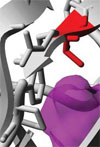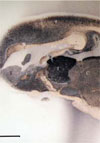Volume 18, Number 1—January 2012
Synopses
An underlying gastrointestinal condition is a risk factor for this disease.
Research
This virus might have caused previously unexplained cerebral infections and deaths in children.
One third of previously treated patients had MDR TB.
Timing of pandemic onset and prior immunity of populations varied by region.
MenY increase was mainly due to sequence type 1655 (clonal complex 23).
These tools enabled laboratory response to the 10-fold increase in testing demands.
Flexible simulation model use can optimize vaccination programs and response to changes in vaccine supply.
Intracerebral inoculation of transgenic mice failed to demonstrate prion disease transmission.
Pertussis incidence among infants can be reduced by early completion of the primary vaccination schedule.
Historical Review
Controversy remains about possible dengue hemorrhagic fever during the epidemic.
The persistent excess in adverse outcomes by ethnicity highlights the need for improved public health responses.
Dispatches
In the United States, recently, there has been an increase in the number of reported clinical and transfusion-transmitted babesiosis cases. Human babesiosis is a tick-borne disease that is generally mild but may cause life-threatening anemia in people at high risk, such as the elderly, who are also likely to receive blood transfusions. Review of the Medicare databases confirmed that most cases recorded in claims data occurred in the northeastern United States, during peak tick season, and also suggested that the disease may be spreading to other regions. Among potential causes for disease expansion are human encroachment into tick and deer habitat, growing deer populations, climatic effects and travel to disease-endemic areas.
In the United States, more than half the cases of tuberculosis (TB) occur in people born outside this country. Many immigrants are assumed to have been infected before coming to the United States; however, genotype matching shows that they can be infected after arrival. Genotype matching compares the genetic make-up of TB isolates from different patients. This article reports on multidrug resistant tuberculosis in patients that were born on different continents and who worked together in the United States. They had TB isolates that shared the same genotype, so their TB probably came from the United States. Nationwide use of genotype matching should help identify the source of other, previously unknown, TB outbreaks.
Rabies is almost always fatal, unless preventive treatment is received soon after exposure. Although usually associated with small wild animals, rabies has recently been found in large captive animals—farmed deer that probably became infected through contact with wildlife. Four deer farmers in Pennsylvania were potentially exposed to rabies and received vaccination against rabies. More cases could be prevented by vaccinating deer against rabies, decreasing wildlife contact with captive deer, and educating deer farmers about their risks.
For more than 60 years, no cases of dengue had been acquired in the continental United States outside the Texas-Mexico border; therefore, a reported suspect case in Florida in 2009 was cause for concern. An investigation, consisting of a survey and blood testing, found 13 Key West residents in the sampled area who had been infected with dengue virus in 2009 and reported no travel outside the United States. From the survey results, researchers estimated that 5% of people in the surveyed area had been infected, which would mean that more infections occurred in 2009 than were reported. Factors that put people at risk for dengue infections included having windows frequently open, using air conditioning less frequently and having yards with large amounts of vegetation or bird baths. Preventing future cases will require personal protection against mosquitoes, mosquito control, early diagnosis, appropriate testing, and prompt reporting of suspected cases. A total of 27 and 66 cases of locally acquired dengue were reported in Key West in 2009 and 2010, respectively. There were no cases of locally acquired dengue in 2011, which is indicative of the success that local health authorities, mosquito control and the public are having in controlling dengue in Key West.
Another Dimension
Brucella abortus may have been the etiologic agent.
Letters
About the Cover
Contact EID journal:
-
Emerging Infectious Diseases journal
Centers for Disease Control and Prevention
1600 Clifton Rd NE
Mailstop D61
Atlanta, GA 30333 -
Phone: (404) 639-1960
Fax: (404) 639-1954 - eideditor@cdc.gov
Get email updates
To receive email updates about this page, enter your email address:








